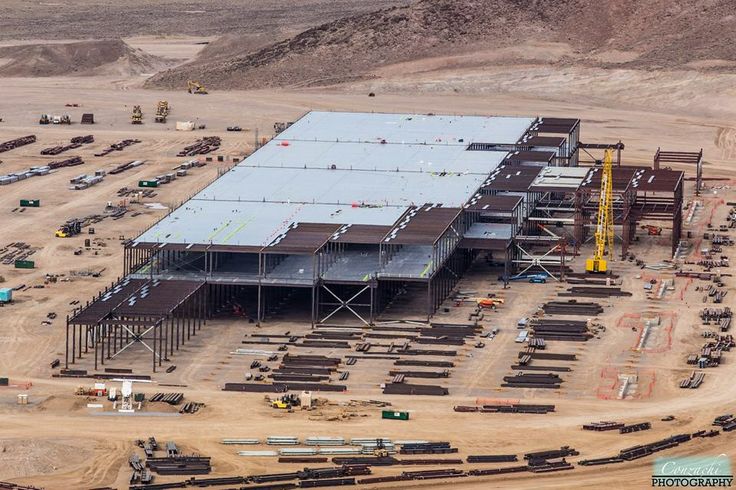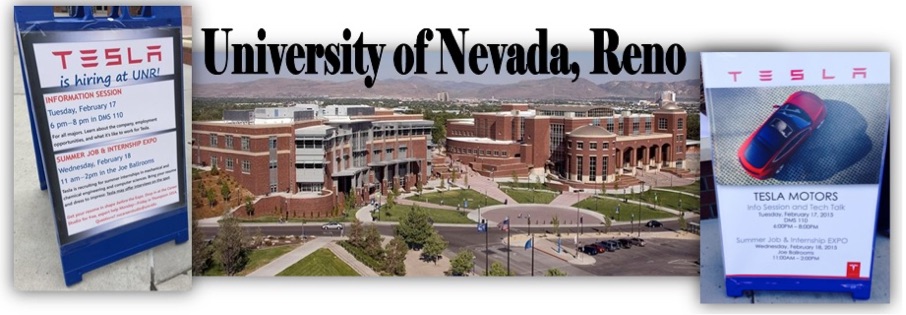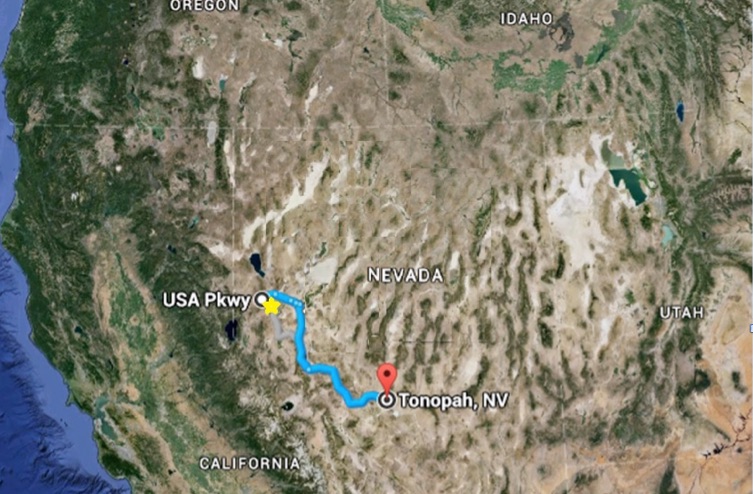News
Tesla Recruiting from University Near the Gigafactory

Tesla contacted the University of Nevada, Reno (UNR) in December 2014 just a few months after the announcement that Northern Nevada will be the location of their new Gigafactory. The motive? Tesla has a standard university internship program that they conduct in many universities as a way to find top talent. Applicants from across the country came for a chance to join Tesla following their announcement that they’re looking to fill 350 internship positions this summer in California. This is one way Tesla keeps a pipeline of skilled workers coming by partnering with academic institutions. Tesla hosted a prelude informational meeting the night before the “Summer Job & Internship Expo”. The event was hosted at the UNR campus with more than 50 businesses ranging from non-profit organizations to Fortune 500 companies attending.
It was standing room only as attendees jammed into a room to hear what it would be like to work for Tesla. The next day there were more than 300 applicants who waited in line for three hours just to be able to make a brief introduction to Tesla. Applicants were advised to ‘dress to impress and have a well-polished resume as interviews might be offered on the spot.
Tesla is staging a job fair at UNR this semester pic.twitter.com/07MTt6fPOl
— Brian Duggan (@brianduggan) February 4, 2015
-->
Because of the popular response, a bigger Expo with more than 100 employers will be hosted on March 12th, 2015 from 10am to 3pm at the Lawlor Event Center. For those who missed Tesla's previous hiring event and/or looking for a 2nd chance to interview with Tesla, this will be the event to attend.
The demand for lithium will drastically increase once the Gigafactory is fully operational. "Right now world consumption of lithium is pretty constant, we use it in a lot of different ways - for batteries in cameras, phones, computers," Carl Nesbitt, associate professor of mining engineering in the College of Science at UNR said. "What the Tesla plant shows is a huge increase in demand for lithium, estimated at perhaps twice the current consumption. It's got to come from somewhere, and Nevada is poised to start producing."
“Nevada is the only place in the northern hemisphere that mines and produces lithium, competing with South American mines in Chile and Bolivia. A mine located near Tonopah currently produces lithium carbonate, the precursor product for lithium batteries, and many prospects have been found in northern Nevada, north of Reno, that will be ready for production to meet the increased demand.” Stated UNR.
"Nevada is number four in the world producing gold and we're a leading producer of silver, but what this allows us to do is put a spotlight on the potential we have for lithium," Nesbitt said. “Chemists in the College of Science are also exploring the electrochemistry of battery technology and how to improve the chemical reactions that make batteries work.”
The choice of Nevada for Tesla’s Gigafactory, the resources our land provides and the skills from the University of Nevada, Reno students and professors creates a partnership that compliments the area.
by Candy Noel
Real Estate Professional at RenoSparksTahoeHomes.com

News
Tesla FSD fleet is nearing 7 billion total miles, including 2.5 billion city miles
As can be seen on Tesla’s official FSD webpage, vehicles equipped with the system have now navigated over 6.99 billion miles.

Tesla’s Full Self-Driving (Supervised) fleet is closing in on almost 7 billion total miles driven, as per data posted by the company on its official FSD webpage.
These figures hint at the massive scale of data fueling Tesla’s rapid FSD improvements, which have been quite notable as of late.
FSD mileage milestones
As can be seen on Tesla’s official FSD webpage, vehicles equipped with the system have now navigated over 6.99 billion miles. Tesla owner and avid FSD tester Whole Mars Catalog also shared a screenshot indicating that from the nearly 7 billion miles traveled by the FSD fleet, more than 2.5 billion miles were driven inside cities.
City miles are particularly valuable for complex urban scenarios like unprotected turns, pedestrian interactions, and traffic lights. This is also the difference-maker for FSD, as only complex solutions, such as Waymo’s self-driving taxis, operate similarly on inner-city streets. And even then, incidents such as the San Francisco blackouts have proven challenging for sensor-rich vehicles like Waymos.
Tesla’s data edge
Tesla has a number of advantages in the autonomous vehicle sector, one of which is the size of its fleet and the number of vehicles training FSD on real-world roads. Tesla’s nearly 7 billion FSD miles then allow the company to roll out updates that make its vehicles behave like they are being driven by experienced drivers, even if they are operating on their own.
So notable are Tesla’s improvements to FSD that NVIDIA Director of Robotics Jim Fan, after experiencing FSD v14, noted that the system is the first AI that passes what he described as a “Physical Turing Test.”
“Despite knowing exactly how robot learning works, I still find it magical watching the steering wheel turn by itself. First it feels surreal, next it becomes routine. Then, like the smartphone, taking it away actively hurts. This is how humanity gets rewired and glued to god-like technologies,” Fan wrote in a post on X.
News
Tesla starts showing how FSD will change lives in Europe
Local officials tested the system on narrow country roads and were impressed by FSD’s smooth, human-like driving, with some calling the service a game-changer for everyday life in areas that are far from urban centers.

Tesla has launched Europe’s first public shuttle service using Full Self-Driving (Supervised) in the rural Eifelkreis Bitburg-Prüm region of Germany, demonstrating how the technology can restore independence and mobility for people who struggle with limited transport options.
Local officials tested the system on narrow country roads and were impressed by FSD’s smooth, human-like driving, with some calling the service a game-changer for everyday life in areas that are far from urban centers.
Officials see real impact on rural residents
Arzfeld Mayor Johannes Kuhl and District Administrator Andreas Kruppert personally tested the Tesla shuttle service. This allowed them to see just how well FSD navigated winding lanes and rural roads confidently. Kruppert said, “Autonomous driving sounds like science fiction to many, but we simply see here that it works totally well in rural regions too.” Kuhl, for his part, also noted that FSD “feels like a very experienced driver.”
The pilot complements the area’s “Citizen Bus” program, which provides on-demand rides for elderly residents who can no longer drive themselves. Tesla Europe shared a video of a demonstration of the service, highlighting how FSD gives people their freedom back, even in places where public transport is not as prevalent.
What the Ministry for Economic Affairs and Transport says
Rhineland-Palatinate’s Minister Daniela Schmitt supported the project, praising the collaboration that made this “first of its kind in Europe” possible. As per the ministry, the rural rollout for the service shows FSD’s potential beyond major cities, and it delivers tangible benefits like grocery runs, doctor visits, and social connections for isolated residents.
“Reliable and flexible mobility is especially vital in rural areas. With the launch of a shuttle service using self-driving vehicles (FSD supervised) by Tesla in the Eifelkreis Bitburg-Prüm, an innovative pilot project is now getting underway that complements local community bus services. It is the first project of its kind in Europe.
“The result is a real gain for rural mobility: greater accessibility, more flexibility and tangible benefits for everyday life. A strong signal for innovation, cooperation and future-oriented mobility beyond urban centers,” the ministry wrote in a LinkedIn post.
News
Tesla China quietly posts Robotaxi-related job listing
Tesla China is currently seeking a Low Voltage Electrical Engineer to work on circuit board design for the company’s autonomous vehicles.

Tesla has posted a new job listing in Shanghai explicitly tied to its Robotaxi program, fueling speculation that the company is preparing to launch its dedicated autonomous ride-hailing service in China.
As noted in the listing, Tesla China is currently seeking a Low Voltage Electrical Engineer to work on circuit board design for the company’s autonomous vehicles.
Robotaxi-specific role
The listing, which was shared on social media platform X by industry watcher @tslaming, suggested that Tesla China is looking to fill the role urgently. The job listing itself specifically mentions that the person hired for the role will be working on the Low Voltage Hardware team, which would design the circuit boards that would serve as the nervous system of the Robotaxi.
Key tasks for the role, as indicated in the job listing, include collaboration with PCB layout, firmware, mechanical, program management, and validation teams, among other responsibilities. The role is based in Shanghai.
China Robotaxi launch
China represents a massive potential market for robotaxis, with its dense urban centers and supportive policies in select cities. Tesla has limited permission to roll out FSD in the country, though despite this, its vehicles have been hailed as among the best in the market when it comes to autonomous features. So far, at least, it appears that China supports Tesla’s FSD and Robotaxi rollout.
This was hinted at in November, when Tesla brought the Cybercab to the 8th China International Import Expo (CIIE) in Shanghai, marking the first time that the autonomous two-seater was brought to the Asia-Pacific region. The vehicle, despite not having a release date in China, received a significant amount of interest among the event’s attendees.










